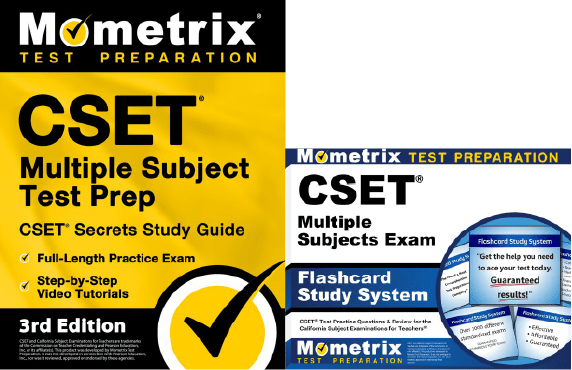If you need help studying for the CSET Multiple Subjects test or just want some more information about what the test is like, you’ve come to the right place!
Click below to take a free CSET Multiple Subjects practice test!
How to Register
How the Exam is Scored
Retaking the Exam
CSET Multiple Subjects Prep Course
FAQs
What’s on the Test?
The CSET Multiple Subjects test contains 154 questions, and you’ll be timed at 5 hours if you take the full test in one sitting. Most of the questions are in your standard multiple-choice format, but 11 of the questions are in a constructed-response format.
The exam is split into three subtests, which you can choose to take separately or together.
Subtest I (101)
56 questions | 3 hours (when taken separately)
Reading, Language and Literature (28 questions)
- Language and linguistics
- Written and non-written communication
- Reading comprehension and analysis
History and Social Science (28 questions)
- World history
- US history
- California history
Subtest II (214)
56 questions | 3 hours (when taken separately)
Science (28 questions)
- Physical sciences
- Life sciences
- Earth and space sciences
Mathematics (28 questions)
- Number sense
- Algebra and functions
- Measurement and geometry
- Statistics, data analysis, and representation of data
Subtest III (225)
42 questions | 2 hours and 15 minutes (when taken separately)
Physical Education (14 questions)
- Movement skills
- Movement knowledge
- Self-image
- Persona development
- Social development
Human Development (14 questions)
- Cognitive development
- Social development
- Physical development
- Influences on development
Visual and Performing Arts (14 questions)
- Dance
- Music
- Theatre
- Visual arts
How to Register
To get started with the registration process, you’ll need to create an NES account on their website. You can then register for the exam via your account.
How the Exam is Scored
The CSET Multiple Subjects test is scored using a scaled scoring method. Here’s how it works:
Scaled Scoring
For every question you answer correctly, you get one point added to your raw score. At the end of the test, your final raw score will be converted to a scaled score ranging from 100 to 300.
The reason your raw score is converted to a scaled score is because everyone that takes the test is given a slightly different set of questions. Since everyone has a different arrangement of questions, and because some questions are harder than others, converting your raw score to a scaled score ensures a more even playing field.
Retaking the Exam
If you don’t get the score you want on your first try, that’s okay! You can take the exam again after a mandatory 45-day waiting period.
CSET Multiple Subjects Prep Course
If you want to be fully prepared, Mometrix offers an online CSET Multiple Subjects prep course. The course is designed to provide you with any and every resource you might want while studying. The CSET Multiple Subjects course includes:
The CSET Multiple Subjects prep course is designed to help any learner get everything they need to prepare for their CSET exam. Click below to check it out!
FAQs
How many questions are on the CSET Multiple Subjects exam?
The exam contains 154 questions.
What is the time limit for the CSET Multiple Subjects exam?
The exam is timed at 5 hours when you take all three subtests together.
What is the passing score for the CSET Multiple Subjects exam?
You’ll need to get a final scaled score of at least 220 on each subtest to pass the full exam.
How much does the CSET Multiple Subjects exam cost?
The testing fee is $247 for the full exam, or $99 for each subtest taken separately.
CSET and California Subject Examinations for Teachers are trademarks of the Commission on Teacher Credentialing and Pearson Education, Inc. or its affiliate(s). This page was developed by Mometrix Test Preparation. It was not developed in connection with Pearson Education, Inc., nor was it reviewed, approved or endorsed by these agencies.



 CSET Online Course
CSET Online Course CSET Study Guide
CSET Study Guide CSET Flashcards
CSET Flashcards

